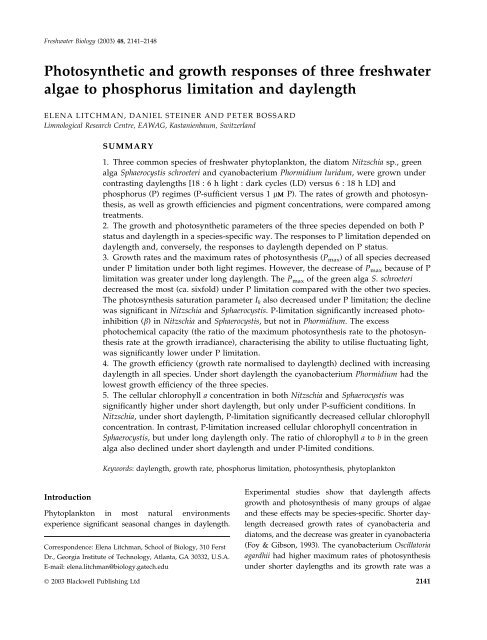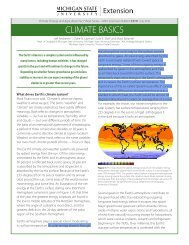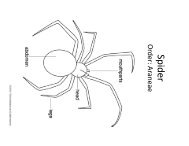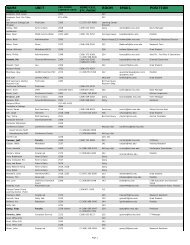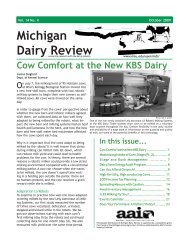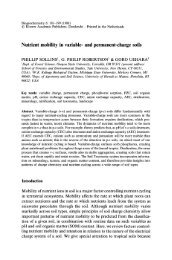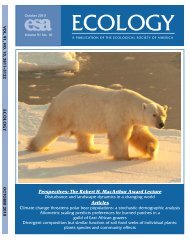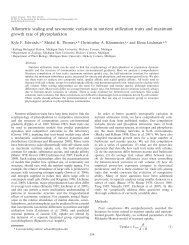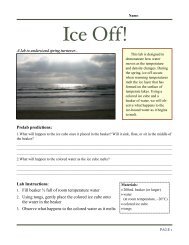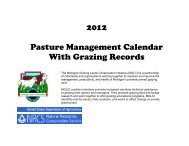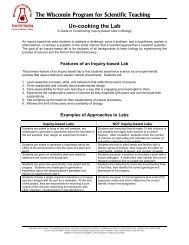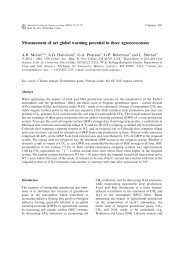litchman et al 2003.pdf - Litchman-Klausmeier Lab
litchman et al 2003.pdf - Litchman-Klausmeier Lab
litchman et al 2003.pdf - Litchman-Klausmeier Lab
You also want an ePaper? Increase the reach of your titles
YUMPU automatically turns print PDFs into web optimized ePapers that Google loves.
Freshwater Biology (2003) 48, 2141–2148Photosynth<strong>et</strong>ic and growth responses of three freshwater<strong>al</strong>gae to phosphorus limitation and daylengthELENA LITCHMAN, DANIEL STEINER AND PETER BOSSARDLimnologic<strong>al</strong> Research Centre, EAWAG, Kastanienbaum, SwitzerlandSUMMARY1. Three common species of freshwater phytoplankton, the diatom Nitzschia sp., green<strong>al</strong>ga Sphaerocystis schro<strong>et</strong>eri and cyanobacterium Phormidium luridum, were grown undercontrasting daylengths [18 : 6 h light : dark cycles (LD) versus 6 : 18 h LD] andphosphorus (P) regimes (P-sufficient versus 1 lM P). The rates of growth and photosynthesis,as well as growth efficiencies and pigment concentrations, were compared amongtreatments.2. The growth and photosynth<strong>et</strong>ic param<strong>et</strong>ers of the three species depended on both Pstatus and daylength in a species-specific way. The responses to P limitation depended ondaylength and, conversely, the responses to daylength depended on P status.3. Growth rates and the maximum rates of photosynthesis (P max ) of <strong>al</strong>l species decreasedunder P limitation under both light regimes. However, the decrease of P max because of Plimitation was greater under long daylength. The P max of the green <strong>al</strong>ga S. schro<strong>et</strong>eridecreased the most (ca. sixfold) under P limitation compared with the other two species.The photosynthesis saturation param<strong>et</strong>er I k <strong>al</strong>so decreased under P limitation; the declinewas significant in Nitzschia and Sphaerocystis. P-limitation significantly increased photoinhibition(b) inNitzschia and Sphaerocystis, but not in Phormidium. The excessphotochemic<strong>al</strong> capacity (the ratio of the maximum photosynthesis rate to the photosynthesisrate at the growth irradiance), characterising the ability to utilise fluctuating light,was significantly lower under P limitation.4. The growth efficiency (growth rate norm<strong>al</strong>ised to daylength) declined with increasingdaylength in <strong>al</strong>l species. Under short daylength the cyanobacterium Phormidium had thelowest growth efficiency of the three species.5. The cellular chlorophyll a concentration in both Nitzschia and Sphaerocystis wassignificantly higher under short daylength, but only under P-sufficient conditions. InNitzschia, under short daylength, P-limitation significantly decreased cellular chlorophyllconcentration. In contrast, P-limitation increased cellular chlorophyll concentration inSphaerocystis, but under long daylength only. The ratio of chlorophyll a to b in the green<strong>al</strong>ga <strong>al</strong>so declined under short daylength and under P-limited conditions.Keywords: daylength, growth rate, phosphorus limitation, photosynthesis, phytoplanktonIntroductionPhytoplankton in most natur<strong>al</strong> environmentsexperience significant season<strong>al</strong> changes in daylength.Correspondence: Elena <strong>Litchman</strong>, School of Biology, 310 FerstDr., Georgia Institute of Technology, Atlanta, GA 30332, U.S.A.E-mail: elena.<strong>litchman</strong>@biology.gatech.eduExperiment<strong>al</strong> studies show that daylength affectsgrowth and photosynthesis of many groups of <strong>al</strong>gaeand these effects may be species-specific. Shorter daylengthdecreased growth rates of cyanobacteria anddiatoms, and the decrease was greater in cyanobacteria(Foy & Gibson, 1993). The cyanobacterium Oscillatoriaagardhii had higher maximum rates of photosynthesisunder shorter daylengths and its growth rate was aÓ 2003 Blackwell Publishing Ltd 2141
2142 E. <strong>Litchman</strong> <strong>et</strong> <strong>al</strong>.saturating function of daylength (Post, Loogman & Mur,1986). Growth rates norm<strong>al</strong>ised to daylength decreasedwith increasing daylength (Tang & Vincent, 2000).The responses of phytoplankton to daylength may<strong>al</strong>so depend on various environment<strong>al</strong> factors. Forexample, Tang & Vincent (2000) showed that growthand photosynth<strong>et</strong>ic responses of an Arctic cyanobacteriumto daylength depended on temperature. Inmany temperate lakes phytoplankton are phosphoruslimitedduring at least part of the year (Hecky &Kilham, 1988). P limitation may modify growth andphotosynth<strong>et</strong>ic responses to daylength. Such influenceof P limitation may be species-specific. At the sam<strong>et</strong>ime, daylength may influence <strong>al</strong>g<strong>al</strong> responses to Plimitation. The differenti<strong>al</strong> physiologic<strong>al</strong> responses ofspecies to P limitation under different daylengths maythen affect community composition. Our modelinvestigations indicate that daylength may affectcomp<strong>et</strong>ition for P among phytoplankton (<strong>Litchman</strong>& <strong>Klausmeier</strong>, 2001; <strong>Litchman</strong>, <strong>Klausmeier</strong> & Bossard,in press), in part because P uptake is light-dependent.Sommer (1994) found that the dynamics and outcomeof comp<strong>et</strong>ition for nutrients among marine phytoplanktondepended on daylength. Moreover, theinteractions b<strong>et</strong>ween light regime and nutrient statusd<strong>et</strong>ermine the nutrition<strong>al</strong> qu<strong>al</strong>ity of phytoplankton forzooplankton (Sterner & Elser, 2002). Therefore it isimportant to assess simultaneous influence of differentdaylengths and P status on phytoplankton.Here we report an investigation of how photosynthesisand growth of three species of freshwaterphytoplankton respond to contrasting daylength andP conditions.Materi<strong>al</strong>s and m<strong>et</strong>hodsAlgae and growth conditionsThree species of freshwater phytoplankton from threemajor taxa were used in the experiments. The diatomNitzschia sp. and the green <strong>al</strong>ga Sphaerocystis schro<strong>et</strong>eriChodat were obtained from the Plant Biology Department,University of Minnesota and the cyanobacteriumPhormidium luridum var. olivace Boresch (UTEX 426) wasobtained from the University of Texas Culture Collection.All these species can be quite common in temperatelakes. The genus Phormidium is similar to the genusOscillatoria in its ecologic<strong>al</strong> niche and can be eitherplanktonic or benthic (Whitford & Schumacher, 1984).Cultures were grown in a temperature-controlledroom at 20 °C on shaker tables (100 r.p.m.). Twodaylengths were used: 18 : 6 and 6 : 18 h LD. Lightwas provided by cool-white fluorescent lamps(Osram, Munich, Germany). In both light regimesthe irradiance (400–700 nm) was 100 lmol quantam )2 s )1 measured with a quantum sc<strong>al</strong>ar sensor(Biospheric<strong>al</strong> Instruments, QSL-100, San Diego, CA,U.S.A.) inside the bottles with the medium. Cultureswere grown in the WC medium (Guillard, 1975) insemicontinuous regime (daily dilutions of 0.2 day )1 ).The WC medium for P-limited cultures had 1 lMphosphate concentration. The cultures were grownunder experiment<strong>al</strong> conditions for at least 4 days(nutrient-repl<strong>et</strong>e conditions) or 8 days (P-limited conditions)before photosynth<strong>et</strong>ic and other param<strong>et</strong>erswere measured.Growth rates were d<strong>et</strong>ermined as the slope of thelinear regression of the natur<strong>al</strong> logarithm of cell densityversus time adjusted for dilution rate. To compare growthefficiency (light utilisation efficiency) b<strong>et</strong>ween daylengths,growth rates were norm<strong>al</strong>ised to daylength.Photosynthesis–irradiance curvesPhotosynthesis–irradiance (P–I) curves were d<strong>et</strong>erminedby 14 C incorporation in the incubator which isa custom modification of the sm<strong>al</strong>l volume photosynth<strong>et</strong>ron(Lewis & Smith, 1983). Samples (7 mL) wereincubated in 20-mL scintillation vi<strong>al</strong>s placed in m<strong>et</strong><strong>al</strong>holders through which water circulated to maintainthe desired temperature. Light was provided from thebottom by four 250 or 400 W high intensity dischargelamps (Osram HQI-D) with the spectrum close tonatur<strong>al</strong> sunlight. The UV portion of the spectrum wasblocked by a she<strong>et</strong> of UV-opaque plexiglas (395 nmcutoff). The platform holding the m<strong>et</strong><strong>al</strong> racks wasshaken constantly so that the samples were shaken aswell. Irradiance was adjusted with layers of neutr<strong>al</strong>density screen. The irradiance was d<strong>et</strong>ermined as theaverage of sever<strong>al</strong> measurements made over 1–2 minand recorded with a LICOR Inc. data logger (Lincoln,NE, U.S.A.) to take into account changes because ofshaking.The samples were incubated for 2 h. After theincubation, 50 lL of 1 N HNO 3 was added andsamples were bubbled with air for 1 h (Gächter &Mares, 1979). Dark uptake measured in triplicate wassubtracted from the light uptake.Ó 2003 Blackwell Publishing Ltd, Freshwater Biology, 48, 2141–2148
Phytoplankton responses to phosphorus and daylength 2143Dissolved inorganic carbon concentration wasd<strong>et</strong>ermined from pH and <strong>al</strong>k<strong>al</strong>inity measurements.Alk<strong>al</strong>inity was d<strong>et</strong>ermined by titration with HCl.Chlorophyll a (and b for S. schro<strong>et</strong>eri) was d<strong>et</strong>erminedafter filtering a sample onto a GF/F filter (WhatmanInternation<strong>al</strong> Ltd, Kent, UK) and extracting chlorophyllin 90% m<strong>et</strong>hanol 10 min at 75 °C. Chlorophyll cin the diatom was not d<strong>et</strong>ermined because the highperformance liquid chromatography (HPLC) systemwas not c<strong>al</strong>ibrated for chlorophyll c. Pigment concentrationswere d<strong>et</strong>ermined using an HPLC system witha LichroSpher 100 RP-18 column (Merck & Co. Inc.,White House Station, NJ, USA) connected to a JascoAS-950 autosampler and PU-980 liquid chromatographysystem. The system was c<strong>al</strong>ibrated with thechlorophyll a and b standards (Fluka).We modelled the P–I data using the hyperbolictangent equation (Jassby & Platt, 1976) modified toinclude photoinhibition: 1P ¼ P max tanhðaI=P max Þð1Þ1 þ bIusing two-way ANOVA. In some cases, to me<strong>et</strong> theassumptions of ANOVA, the data were log-transformed.Student–Neuman–Keuls test was used formultiple pairwise comparisons. Within each factor(daylength or P status) treatments were comparedusing a t-test.ResultsPhotosynth<strong>et</strong>ic param<strong>et</strong>ersBoth daylength and P status influenced photosynth<strong>et</strong>icparam<strong>et</strong>ers of <strong>al</strong>l three species (Fig. 1; Table 1).The maximum rates of photosynthesis (P max ) norm<strong>al</strong>isedto chlorophyll a (P max /Chl a ¼ Assimilationwhere P is the rate of photosynthesis at irradiance I,P max is the maximum potenti<strong>al</strong> light-saturated photosynth<strong>et</strong>icrate (with no photoinhibition), a is the initi<strong>al</strong>slope of the P–I curve and b characterises inhibition ofphotosynthesis at high irradiance. We <strong>al</strong>so d<strong>et</strong>erminedI k , the saturation param<strong>et</strong>er, as the ratio of P max to a.The hyperbolic tangent equation (eqn 1) gaveslightly higher R 2 for most P–I curves than theequation by Platt, G<strong>al</strong>legos & Harrison (1980); therefore,here we report and compare param<strong>et</strong>ers for thisequation only. Previous studies noted that photosynth<strong>et</strong>icparam<strong>et</strong>ers such as a can only be comparedwhen the same equation is used (Fren<strong>et</strong>te <strong>et</strong> <strong>al</strong>., 1993).At least two, and in most cases three or four,replicate cultures were grown under each combinationof daylength and P concentration and the P–I curveswere d<strong>et</strong>ermined for each culture. We <strong>al</strong>so d<strong>et</strong>erminedthe excess photochemic<strong>al</strong> capacity as the ratio of themaximum photosynth<strong>et</strong>ic rate, P max to the photosynth<strong>et</strong>icrate under growth irradiance, P g (Cullen &MacIntyre, 1998). High excess photochemic<strong>al</strong> capacityindicates good capability to utilise fluctuating light.Statistic<strong>al</strong> an<strong>al</strong>ysesThe effects of daylength, P concentration and theirinteraction on various param<strong>et</strong>ers were an<strong>al</strong>ysedFig. 1. Representative P–I curves for the three species. (a)Nitzschia; (b) Sphaerocystis; (c) Phormidium. LDL, long daylength;SDL, short daylength; P-lim, P-limited; P-suff, P-sufficientcultures.Ó 2003 Blackwell Publishing Ltd, Freshwater Biology, 48, 2141–2148
2144 E. <strong>Litchman</strong> <strong>et</strong> <strong>al</strong>.Table 1. Various physiologic<strong>al</strong> param<strong>et</strong>ers of the three species under different light regimes and P conditionsLight regimePconditionsNitzschia Sphaerocystis PhormidiumLDL SDL LDL SDL LDL SDLa, ·10 )2 , mg C mg Chlorophyll h )1 P-sufficient 4.2 ± 1.2 4.9 ± 0.8 5.4 ± 1.0 4.6 ± 0.5 7.4 ± 2.0 6.8 ± 0.4P-limited 2.7 ± 0.2 5.2 ± 0.2 3.0 ± 0.8 3.8 ± 0.3 2.6 ± 0.1 6.4 ± 0.7I k , lmol quanta m )2 s )1 P-sufficient 91.5 ± 15.3 106.7 ± 12.24 127.8 ± 36.5 132.4 ± 10.8 138.5 ± 15.3 104.7 ± 15.7P-limited 52.8 ± 4.2 65.8 ± 13.0 59.6 ± 15.6 71.4 ± 4.6 93.5 ± 13.9 70.8 ± 10.8b, ·10 )4 P-sufficient 1.0 ± 3.5 )4.5 ± 1.7 )3.1 ± 0.6 )1.4 ± 0.3 )8.7 ± 0.3 )8.1 ± 0.5P-limited )7.6 ± 1.4 )4.8 ± 0.7 )6.1 ± 1.4 )3.2 ± 1.1 )8.4 ± 1.5 )7.9 ± 1.0Chlorophyll a, pg cell )1 P-sufficient 4.4 ± 1.6 13.4 ± 0.7 12.7 ± 3.6 28.6 ± 2.6 nd ndP-limited 3.4 ± 1.0 8.9 ± 3.3 35.7 ± 7.0 34.6 ± 10.0 nd ndChlorophyll a:b P-sufficient na na 3.31 ± 0.01 2.9 ± 0.08 nd ndP-limited na na 2.61 ± 0.07 2.76 ± 0.12 nd ndGrowth rate, day )1 P-sufficient 0.87 ± 0.09 0.32 ± 0.04 0.62 ± 0.07 0.32 ± 0.08 0.54 ± 0.10 0.23 ± 0.07P-limited 0.16 ± 0.05 0.09 ± 0.04 0.16 ± 0.05 0.10 ± 0.03 0.13 ± n.d. 0.07 ± 0.04Excess photochemic<strong>al</strong> capacity P-sufficient 1.26 ± 0.06 1.31 ± 0.08 1.52 ± 0.16 1.55 ± 0.09 1.48 ± 0.12 1.25 ± 0.11P-limited 1.00 ± 0.03 1.06 ± 0.06 1.03 ± 0.03 1.10 ± 0.02 1.34 ± 0.19 1.05 ± 0.06LDL, long daylength (18 : 6 h LD); SDL, short daylength (6 : 18 h LD); na, not applicable; nd, not d<strong>et</strong>ermined.Excess photochemic<strong>al</strong> capacity was d<strong>et</strong>ermined as the ratio of P max , maximum rate of photosynthesis to the P g , the photosynth<strong>et</strong>ic rateat the growth irradiance (Cullen & MacIntyre, 1998).number) in <strong>al</strong>l species were significantly lower underP-limited conditions (Fig. 2). The decrease of P max du<strong>et</strong>o P limitation (DP max ¼ P suff ) P lim ) was greaterunder long daylength (LDL) than under short daylength(SDL). The decline of P max under P-limitationwas the most pronounced in Sphaerocystis under LDL(more than sixfold, p < 0.01), in Nitzschia it wasthreefold (p < 0.05) and in Phormidium it was2.6-fold (p < 0.05) (Fig. 2). Also, the difference in theP max decrease because of P-limitation b<strong>et</strong>weenLDL and SDL {difference ¼ [(P-suff LDL – P-lim LDL )–(P-suff SDL – P-lim SDL )]} was the greatest in Sphaerocystis.Under P limitation the daylength had a strongeffect on P max : it was significantly higher under SDLthan under LDL (Fig. 2). The saturation param<strong>et</strong>er I k<strong>al</strong>so decreased under P limitation under both SDL andLDL (see Table 1). The decrease was significant inNitzschia (p ¼ 0.018) and Sphaerocystis (p < 0.001).The initi<strong>al</strong> slope of the P–I curves a appeared to behigher in P-sufficient cultures, the difference was not,however, significant in Nitzschia and Sphaerocystis. InPhormidium, both P status and the interaction term(daylength by P status) significantly influenced a(p ¼ 0.016 and 0.033, respectively, two-way ANOVA).P-sufficient Phormidium cultures had significantlyhigher a compared with P-limited cultures, but onlyunder LDL. Under P-limited conditions, the LDLcultures had significantly lower a than the SDLcultures of Phormidium.Under P-sufficient conditions, the cyanobacteriumPhormidium was significantly more inhibited (greaterb) than the diatom Nitzschia and the chlorophyteSphaerocystis (one-way ANOVA, p¼ 0.005). P-limitationsignificantly increased photoinhibition inNitzschia (two-way ANOVA, p¼ 0.034) and Sphaerocystis(p ¼ 0.048), but not in Phormidium. InNitzschia,photoinhibition was different b<strong>et</strong>ween P-limited andP-sufficient cultures only under LDL.The excess photochemic<strong>al</strong> capacity (EPC) decreasedunder P limitation; the difference was highly significantfor both Nitzschia and Sphaerocystis (p ¼ 0.002and 0.05).Growth ratesGrowth rates of <strong>al</strong>l species decreased significantlyunder P limitation under both light regimes. Thedecline due to P limitation was more pronouncedunder LDL (Table 1). The growth rate of Nitzschiadeclined more than fivefold under this light regimeversus 3.6-fold under the short daylength.Under P-sufficient conditions, the growth rateswere the lowest under the shortest daylength andincreased linearly with daylength in Sphaerocystis[growth rate ¼ (0.0217 · daylength) + 0.2; R 2 ¼ 0.98]and Phormidium [growth rate ¼ (0.0308 · daylength) +0.03; R 2 ¼ 0.98] (Fig. 3a). The growth rates underÓ 2003 Blackwell Publishing Ltd, Freshwater Biology, 48, 2141–2148
Phytoplankton responses to phosphorus and daylength 2145Fig. 3. (a) Growth rates of the three species and (b) daylengthnorm<strong>al</strong>isedgrowth rates (growth efficiencies) under differentlight regimes and nutrient-sufficient conditions for Nitzschia(cross), Sphaerocystis (circle) and Phormidium (diamond). Growthrates at the 24 h daylight were taken from <strong>Litchman</strong> (2000).Fig. 2. Chlorophyll-norm<strong>al</strong>ised maximum rates of photosynthesisof the three species under P-limited and nutrient-sufficientconditions. (a) Nitzschia; (b) Sphaerocystis; (c) Phormidium. Openbars are long daylength treatments and hatched bars are shortdaylength treatments.continuous irradiance of 100 lmol quanta m )2 s )1were taken from <strong>Litchman</strong> (2000). In Nitzschia, thegrowth rate dependence on daylength was b<strong>et</strong>terdescribed by a saturating curve (Fig. 3a) {growthrate ¼ [)0.0036 · (daylength) 2 ] + (0.1314 · daylength) )0.34; R 2 ¼ 1} (Fig. 3a).Under P-sufficient conditions growth rates norm<strong>al</strong>isedto light dose (growth efficiency) were the greatestunder the shortest daylength (Fig. 3b). The growth(light utilisation) efficiency increased with decreasingdaylength in <strong>al</strong>l species. The pattern of increase was,however, species-specific: the increase was less pronouncedin Phormidium compared with Nitzschia andSphaerocystis (Fig. 3b).Cellular chlorophyll concentrationsChlorophyll concentration (measured in Sphaerocystisand Nitzschia, no data for Phormidium) tended to behigher under SDL (Table 1). Under P-sufficient conditions,the effect of daylength on cellular chlorophyllÓ 2003 Blackwell Publishing Ltd, Freshwater Biology, 48, 2141–2148
2146 E. <strong>Litchman</strong> <strong>et</strong> <strong>al</strong>.concentration was much more pronounced thanunder P-limited conditions. In Nitzschia, the effect ofboth P-status and daylength on cellular chlorophyllconcentration were highly significant, as well as theirinteraction term (p ¼ 0.003, 0.002 and 0.01). In bothNitzschia and Sphaerocystis, the LDL treatments hadsignificantly lower chlorophyll a concentrations thanthe SDL treatments, but only under P-sufficientconditions (Table 1). P-limitation significantly decreasedchlorophyll concentration in Nitzschia, butunder SDL only. In Sphaerocystis, under LDL only,P-limited cultures had higher cellular chlorophyllconcentration than P-sufficient cultures (p ¼ 0.035).The ratio of chlorophyll a to b in Sphaerocystis underLDL was significantly higher (p < 0.001) in nutrientsufficientcultures compared with its P-limited cultures(3.3 versus 2.6, respectively). The interactionterm of daylength and P limitation (daylength · Pstatus) was <strong>al</strong>so significant (p ¼ 0.038). UnderP-sufficient conditions, the chlorophyll a : b ratio <strong>al</strong>sosignificantly depended on daylength: it was 3.3 underLDL versus 2.9 under SDL, p < 0.01).DiscussionBoth P limitation and daylength had significant effectson major physiologic<strong>al</strong> param<strong>et</strong>ers of the threespecies. The growth rates of <strong>al</strong>l three species declinedunder short daylength and the decline was speciesspecific.Nicklisch (1998) <strong>al</strong>so observed a speciesspecificdecrease in growth rates under shortdaylength. The ratio of the growth rate undercontinuous light to the growth rate under the shortestphotoperiod was the greatest in the cyanobacterium,indicating the greatest inhibition of growth fromshortening the daylength. Foy & Gibson (1993) <strong>al</strong>sofound greater decline in growth with decreasingphotoperiod in cyanobacteria compared with diatoms.A decline in growth rate efficiency (growth rate perlight hour) with increasing daylength has <strong>al</strong>so beenobserved for many other species in both freshwaterand marine environments (Gilstad & Sakshaug, 1990;Foy & Gibson, 1993; Tang & Vincent, 2000). Thecyanobacterium had a relatively low growth efficiencyunder short daylength compared with the diatom andthe green <strong>al</strong>ga. However, the growth efficiencies weresimilar for the three species under continuous light.This may contribute to the dominance of cyanobacteriain the summer, under long daylengths and to theirdisadvantage in the spring and f<strong>al</strong>l when the daylengthis shorter.The responses of photosynth<strong>et</strong>ic param<strong>et</strong>ers toshortening of daylength were similar to the lowirradiance acclimation. The increase in cellular chlorophylla concentration under shorter light periodsappears to be similar to the increase under lowerirradiance and has been observed in other species,such as the cyanobacterium O. agardhii (Post <strong>et</strong> <strong>al</strong>.,1986). The ratio of chlorophyll a to b is <strong>al</strong>so known todecline under low light (Maxwell <strong>et</strong> <strong>al</strong>., 1994; F<strong>al</strong>kowski& Raven, 1997). In the present study undernutrient-sufficient conditions the chlorophyll a:bratio was significantly lower under short daylength.P limitation decreased the maximum rates ofphotosynthesis in <strong>al</strong>l three species, but the decreasewas species-specific: the green <strong>al</strong>ga was the mostsensitive to P limitation and the diatom was the leastsensitive. Many other studies have reported lowerrates of light-saturated photosynthesis under P limitation(Senft, 1978; Geider <strong>et</strong> <strong>al</strong>., 1998). The susceptibilityto photoinhibition <strong>al</strong>so increased due toP-limitation in Nitzschia and Sphaerocystis. A greaterphotoinhibition of photosynthesis in nutrient-limitedphytoplankton has been reported previously (<strong>Litchman</strong>,Ne<strong>al</strong>e & Banaszak, 2002). A decrease in cellularchlorophyll concentration under P-limitation has beenobserved for both marine and freshwater micro<strong>al</strong>gae(Geider <strong>et</strong> <strong>al</strong>., 1998; Wykoff <strong>et</strong> <strong>al</strong>., 1998). An increase incellular chlorophyll concentration under P-limitationin Sphaerocystis may possibly be explained by slowercellular division rates resulting in larger cells withhigher chlorophyll content. The effect of nutrientlimitation on photosynth<strong>et</strong>ic apparatus in somerespects is similar to the effect of low irradiance, withdecreased maximum rate of photosynthesis and lowersaturation param<strong>et</strong>er v<strong>al</strong>ues. Lower chlorophyll-specificmaximum rates of photosynthesis as well aslower chlorophyll a:b ratios are characteristic forlow-light acclimated phytoplankton. In the presentstudy we observed significantly lower chlorophylla:bratio under P-limited conditions. P limitation <strong>al</strong>sodecreased excess photochemic<strong>al</strong> capacity (Cullen &MacIntyre, 1998), suggesting that nutrient-limitedphytoplankton are less capable of utilising lightfluctuations.The effect of P limitation on the rates of photosynthesisand the degree of photoinhibition was morepronounced under long daylength. It is possible thatÓ 2003 Blackwell Publishing Ltd, Freshwater Biology, 48, 2141–2148
Phytoplankton responses to phosphorus and daylength 2147by <strong>al</strong>lowing faster growth, longer daylength leads to astronger P limitation and subsequently to a greaterdecrease in the light-saturated rates of photosynthesisand greater susceptibility to photoinhibition. LowerP max have been reported for <strong>al</strong>gae grown under longerdaylength under nutrient sufficient conditions (Nielsen,1997). In our study this effect of daylength wassignificant only under P-limited conditions.Under nutrient-sufficient conditions daylength hada significant effect on growth rates and chlorophyllconcentrations. The results show that the growth andphotosynth<strong>et</strong>ic responses to P limitation <strong>al</strong>so dependon daylength, with stronger effects of limitation underlonger daylength. Both photosynth<strong>et</strong>ic and growthrates declined more under LDL due to P limitation. Itis thus important when in the season P limitationoccurs: the effects of P limitation on photosynthesiswould be less pronounced in the early spring andautumn.AcknowledgementsEL was supported by the Swiss NSF (SNF) grant 31-50803.97. We thank Professor R.I. Jones and twoanonymous reviewers for their helpful comments andsuggestions.ReferencesCullen J.J. & MacIntyre J.G. (1998) Behavior, physiologyand the niche of depth-regulating phytoplankton. In:Physiologic<strong>al</strong> Ecology of Harmful Alg<strong>al</strong> Blooms, vol. 41(ed. D.M. Anderson, A.D. Cembella & G.M. H<strong>al</strong>legraeff), pp. 559–579. Springer, Berlin.F<strong>al</strong>kowski P.G. & Raven J.A. (1997) Aquatic Photosynthesis.Blackwell Science, M<strong>al</strong>den.Foy R.H. & Gibson C.E. (1993) The influence ofirradiance, photoperiod and temperature on thegrowth kin<strong>et</strong>ics of three planktonic diatoms. EuropeanJourn<strong>al</strong> of Phycology, 28, 203–212.Fren<strong>et</strong>te J.-J., Demers S., Legendre L. & Dodson J. (1993)Lack of agreement among models for estimating thephotosynth<strong>et</strong>ic param<strong>et</strong>ers. Limnology and Oceanography,38, 679–687.Gächter R. & Mares A. (1979) Comments on theacidification and bubbling m<strong>et</strong>hods for d<strong>et</strong>erminingphytoplankton production. Oikos, 33, 69–73.Geider R.J., MacIntyre H.L., Graziano L.M. & McKayR.M.L. (1998) Responses of the photosynth<strong>et</strong>ic apparatusof Dun<strong>al</strong>iella tertiolecta (Chlorophyceae) tonitrogen and phosphorus limitation. European Journ<strong>al</strong>of Phycology, 33, 315–332.Gilstad M. & Sakshaug E. (1990) Growth rates of ten diatomspecies from Barents Sea at diferent irradiances and daylengths. Marine Ecology Progress Series, 64, 169–173.Guillard R.R.L. (1975) Culture of phytoplankton forfeeding marine invertebrates. In: Culture of marineinvertebrate anim<strong>al</strong>s (ed. W.L. Smith & M.H. Chanley),pp. 29–60. Plenum Press, New York.Hecky R.E. & Kilham P. (1988) Nutrient limitation ofphytoplankton in freshwater and marine environments.Limnology and Oceanography, 33, 786–822.Jassby A.D. & Platt T. (1976) Mathematic<strong>al</strong> formulation ofthe relationship b<strong>et</strong>ween photosynthesis and light forphytoplankton. Limnology and Oceanography, 21, 540–547.Lewis M.R. & Smith J.C. (1983) A sm<strong>al</strong>l volume, shortincubation-timem<strong>et</strong>hod for measurement of photosynthesisas a function of incident irradiance. MarineEcology Progress Series, 13, 99–102.<strong>Litchman</strong> E. (2000) Growth rates of phytoplankton underfluctuating light. Freshwater Biology, 44, 223–235.<strong>Litchman</strong> E. & <strong>Klausmeier</strong> C.A. (2001) Comp<strong>et</strong>ition ofphytoplankton under fluctuating light. American Natur<strong>al</strong>ist,157, 170–187.<strong>Litchman</strong>, E., Ne<strong>al</strong>e, P.J. & Banaszak, A.T. (2002)Increased sensitivity to ultraviol<strong>et</strong> radiation in nitrogen-limiteddinoflagellates: photoprotection andrepair. Limnology and Oceanography, 47, 86–94.<strong>Litchman</strong> E., <strong>Klausmeier</strong> C.A. & Bossard P. Phytoplanktonnutrient comp<strong>et</strong>ition under dynamic light regimes.Limnology and Oceanography, in press.Maxwell D.P., F<strong>al</strong>k S., Trick C.G. & Huner N.P.A. (1994)Growth at low temperature mimics high light acclimationin Chlorella vulgaris. Plant Physiology, 105, 535–543.Nicklisch A. (1998) Growth and light absorption of someplanktonic cyanobacteria, diatoms and Chlorophyceaeunder simulated natur<strong>al</strong> light fluctuations. Journ<strong>al</strong> ofPlankton Research, 20, 105–119.Nielsen M.V. (1997) Growth, dark respiration andphotosynth<strong>et</strong>ic param<strong>et</strong>ers of the coccolithophoridEmiliania huxleyi (Prymnesiophyceae) acclimated todifferent day length-irradiance combinations. Journ<strong>al</strong> ofPhycology, 33, 818–822.Platt T., G<strong>al</strong>legos C.L. & Harrison W.G. (1980) Photoinhibitionof photosynthesis in natur<strong>al</strong> assemblages ofmarine phytoplankton. Journ<strong>al</strong> of Marine Research, 38,687–701.Post A.F., Loogman J.G. & Mur L.R. (1986) Photosynthesis,carbon flows and growth of Oscillatoria agardhiiGomont in environments with a periodic supply oflight. Journ<strong>al</strong> of Gener<strong>al</strong> Microbiology, 132, 2129–2136.Ó 2003 Blackwell Publishing Ltd, Freshwater Biology, 48, 2141–2148
2148 E. <strong>Litchman</strong> <strong>et</strong> <strong>al</strong>.Senft W.H. (1978) Dependence of light-saturated rates of<strong>al</strong>g<strong>al</strong> photosynthesis on intracellular concentrations ofphosphorus. Limnology and Oceanography, 23, 709–718.Sommer U. (1994) The impact of light intensity anddaylength on silicate and nitrate comp<strong>et</strong>ition amongmarine phytoplankton. Limnology and Oceanogaphy, 39,1680–1688.Sterner R.W. & Elser J.J. (2002) Ecologic<strong>al</strong> stoichiom<strong>et</strong>ry: thebiology of elements from molecules to the biosphere.Princ<strong>et</strong>on University Press, Princ<strong>et</strong>on.Tang E.P.Y. & Vincent W.F. (2000) Effects of daylengthand temperature on the growth and photosynthesis ofan Arctic cyanobacterium, Schizothrix c<strong>al</strong>cicola (Oscillatoriaceae).European Journ<strong>al</strong> of Phycology, 35, 263–272.Whitford L.A. & Schumacher G.J. (1984) A Manu<strong>al</strong> ofFresh-Water Algae. Sparks Press, R<strong>al</strong>eigh, NC.Wykoff D.D., Davies J.P., Melis A. & Grossman A.R.(1998) The regulation of photosynth<strong>et</strong>ic electron transportduring nutrient deprivation in Chlamydomonasreinhardtii. Plant Physiology, 117, 129–139.(Manuscript accepted 11 September 2003)Ó 2003 Blackwell Publishing Ltd, Freshwater Biology, 48, 2141–2148


